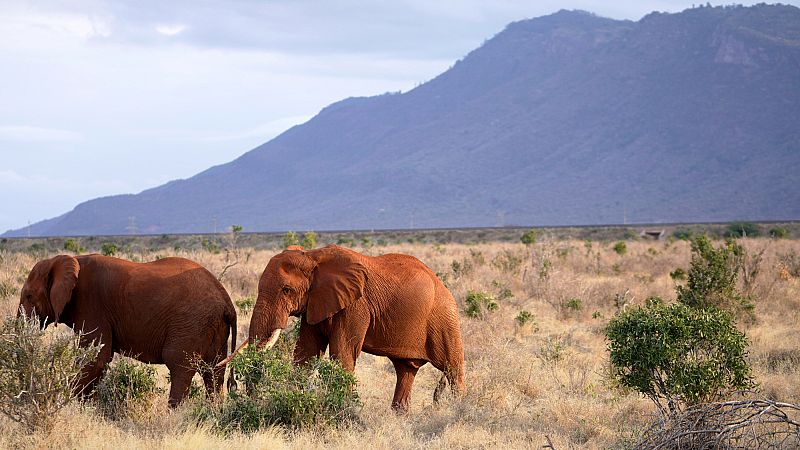Kenyan farmers use nature for peaceful human-elephant coexistence

Elephants roam the mountainous region of Taita Taveta in Kenya.
As they cross the land, they graze on plants, stripping leaves from trees and bushes along the way.
It takes a lot to feed a beast this big - the average African elephant can eat
150kg or more of vegetation a day.
And that appetite can put them in conflict with their human neighbours as they search for food using routes that have been passed down through generations of elephants.
They raid crops and will occasionally injure or even kill people.
Farmers like Getrude Jackim have been battling wild elephants for decades.
The animals are most likely to invade their land and eat the plants between October and January. They migrate elsewhere in February.
Jackim has cultivated crops here for 20 years.
She used to plant things like maize.
But because of the elephants, she has changed her strategy.
"Before, we used to plant maize, mung beans, cassava and pigeon peas. But now the elephants are increasingly raiding our farms and some of us can't confront them. Someone like me can't confront them because I'm too old to chase after them. Therefore, I am doing sesame farming because the elephants can't eat it because of its scent," she explains.
The sesame plant produces a natural scent that elephants dislike and keeps them off farms.
Jackim is among 100 farmers who have been supported to adopt sesame seed production as a way to deter elephant invasions.
Richard Shika has found another way to ward off the animals.
Elephants don't like bees, so the farmer has set up a series of hives on his land.
The beehives are hung using wires on two poles so that touching them will rock them and disturb the bees.
With support from wildlife conservation organisation Save The Elephant, at least 50 farmers have set up these beehive fences, which act as a natural deterrent for elephants as well as a source of livelihood through the sale of honey.
"If the elephants raid my crops, at least I can get honey from the beehives. I can sell the honey. Between January and March, I harvested approximately five kilograms. Between April and June, I harvested 24 kilograms, yielding a total of 20,000 Kenya shillings ($154) from the 24 kilograms. Additionally, I earned 12,000 shillings ($92) from the five kilograms harvested during the same period. I can educate my children. Apart from just deterring elephants, we get honey from the beehives," says Shika.
These methods, the farmers say, promote peaceful coexistence between wildlife and humans.
Shika used to have to use flaming sticks and dogs to keep the elephants off his land.
But even that proved futile - during one raid, he narrowly escaped after an elephant stepped on a torch and charged at him.
With conservation and anti-poaching efforts gradually allowing elephants to thrive and increase in population, human-wildlife conflict has soared.
This has been exacerbated by human population growth, with conservationists now calling for innovative and natural mechanisms for coexistence.
Yuka Luvonga, from Save The Elephants, says that a major cause of conflict is the encroachment on the native migratory routes of elephants.
"When poaching was eradicated from the world map and considered illegal, that's when the number of elephants started increasing again, and with that increase, we found that there was a spike in human-elephant conflict," he says.
"We find the places or the infrastructures we use as humans, we do develop, they are the ones that hinder the migratory routes and paths which elephants used to take, maybe to go for water sources or maybe to look for herbs or a certain kind of trees."
Kenya Wildlife Service and conservation organisations tracking human-elephant conflict estimate that 30-35 people are killed every year in elephant-related incidents across Kenya.
Communities will sometimes retaliate by spearing or poisoning elephants.
But instead of confrontation with the elephants, using nature as an ally to deter them, whether through crop selection or beehive barriers, is one way of keeping both animals and humans safe.
The Tsavo National Park is a crucial wildlife reserve and provides sanctuary to some of the largest wild African elephants as well as other animals.
World Elephant Day is marked on 12th August.
Today

